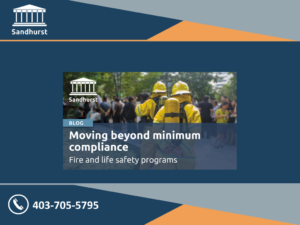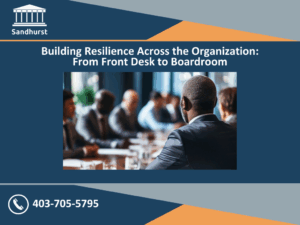Leadership in Crisis: the 10 Diseases
About Our Speaker
Paul Flavell, COO at Sandhurst Consulting, brings deep experience to the subject of leadership under pressure. With 18 years as a British Army Infantry Officer—including operational deployments in Northern Ireland, Bosnia, Sierra Leone, Iraq, and Afghanistan—and a year of rigorous training at the Royal Military Academy Sandhurst, Paul has lived leadership at its most intense. Transitioning into emergency management (EM), he continues to ensure organizations and teams are prepared to lead effectively in dynamic, high-stress environments.
Session Objective
This session was designed to provide leaders and their organizations with clear visibility into the subtle, corrosive leadership failures that undermine organizational effectiveness, especially during emergencies. By walking you through Professor Richard Holmes’ “10 Diseases of Leadership,” using real-world examples ranging from military operations to historic disasters, the objective is to arm you with actionable tools, not just to spot these failures in others, but to stay vigilant against them in your own leadership practice.
Key Points & Takeaways from this session
Leadership Is Central in Emergency Management
Leadership goes far beyond organizing resources and issuing directives. In emergency management, as in the military, leadership is about creating the conditions under which people can excel, adapt, and do what’s right—especially when uncertainty and risk are highest. You are not just managing processes, you are forging trust, accountability, and resilience within your team and organization.
Leadership Failures Are Often Subtle and Cumulative
The “10 Diseases” are not spectacular one-time errors but gradual, sometimes invisible, errors-in-judgment or organizational culture drift. These are patterns of neglect and habit that slowly build, only revealing their true cost at the worst possible moment—when the crisis hits.
Here they are:
Paul presented some high-profile case studies to breathe life into Holmes’ list drawing out lessons for every professional in Emergency Management:
1. Lack of Moral Courage
This is the failure to do what’s right when it’s difficult, unpopular, or costly. Leaders must have the backbone to say “no” when it matters, to stand up to pressure even in the face of likely backlash. In your organization, think about that moment when you knew the right action but hesitated. Did it erode your standards? Did your team stop trusting you to do the right thing?

• Example: NASA’s Challenger disaster—leadership buckled to political and schedule pressure, ignoring valid technical warnings. The result was catastrophic.
• Your Lesson: Ensure your Moral Compass remains firm, even when you have to make the unpopular decision.
2. Failure to Recognize Loyal OppositionHigh-functioning teams thrive on healthy dissent. When you, as a leader, treat honest, informed disagreement as an attack or disloyalty, you silence the very voices that could help safeguard your mission.
Example: Boeing’s 737 MAX crisis—engineers’ voiced safety concerns were sidelined, resulting in loss of life and enormous reputational damage.
Your takeaway: Create spaces where your team can, and should challenge you. Loyalty often comes in the form of hard truths.
3. Consent and Evade
This is the organizational habit of public agreement followed by private neglect. People nod their heads in meetings, commit verbally, then fail to act.
• Example: Hurricane Katrina—many agencies agreed on paper to get vulnerable residents to safety, but when the storm hit, promises evaporated and buses never arrived.

• Your lesson: Don’t be satisfied with surface-level agreement. Insist on accountability and follow-through.
4. Information Hoarding (“Need to Know—And You Don’t Need to Know”)When information is used as personal power, withheld from others in your team, you guarantee blind spots and missed opportunities.
• Example: Pre-9/11 intelligence agencies—failure to share critical data meant the pieces never came together to stop a tragedy.
• Your challenge: Break down silos. Share information broadly. Your team’s performance depends on it.
5. Closed-Mindedness
(“Don’t Bother Me With the Facts—I’ve Already Made Up My Mind”)
Some leaders confuse decisiveness with stubbornness. Once a decision is made, they ignore contrary evidence that could save lives, money, or reputation.
• Example: Deepwater Horizon—leaders rationalized away repeated warnings and pressure test results, clinging to pre-existing conclusions. The price: disaster, death, and environmental damage.
• For you: Foster a culture where facts speak louder than rank or previous plans.
6. The Quest for the 100% Solution
Perfectionism in crisis can be fatal. Waiting for total certainty usually means missing your chance to act.
• Example: Fukushima—leaders waited for more data before expanding evacuations or venting reactors, which delayed vital actions and needlessly increased harm.
• Your shift: Act even with incomplete data. EM rarely offers 100% certainty; 70% clarity and bold adaptive action win the day.
7. Equating Quality of Advice With Rank
If you only listen to “experts” or people at the top of the org chart, you miss invaluable frontline wisdom.
• Example: The Grenfell Tower fire—residents’ repeated warnings about safety were ignored because they weren’t viewed as credible. The price: 72 lives lost.

• In your team: Consider that the best insights may come from the grassroots—frontline responders, local citizens, and/or volunteers.
8. “I’m Too Busy to Win”
Many leaders trap themselves in endless tasks, failing to pause and consider wider risks or strategic direction.
• Example: Titanic’s leadership was overwhelmed by daily routine and ignored persistent strategic warnings (icebergs). Catastrophe followed.
• For you: Step back regularly. Reflect and scan the horizon as part of your routine.
9. “I Can Do Your Job Too”
Micromanagement in a crisis drains organizational energy and confuses roles.
• Example: Hurricane Katrina—senior leaders, desperate to help, stepped into operational tasks, abandoning essential strategic coordination.
• For us: Trust your team. Delegate. Lead, don’t do.
10. “Big Man, Cold Shadow”
When leadership becomes intimidating, dissent disappears and disaster can strike.
• Example: Yarnell Hill Fire—an authoritative command culture deterred challenge and red-flag-raising, leading to the death of 19 firefighters.
• Action for your organization: Create psychological safety. Encourage, expect, and thank people for raising concerns.
Antidotes: How You and Your Team Can Prevail
Paul elaborated on three main strategies to prevent your team and yourself from falling into typical patterns that impede leadership abilities to act effectively in time of crisis.
a. Self-Awareness
You must see yourself clearly—even, and especially, under stress. Build mirrors into your leadership by encouraging honest feedback, conducting after-action reviews, recording your lessons daily, and deliberately asking colleagues where your “blind spots” are. A culture that values ongoing, genuine feedback helps you correct course before minor habits become fatal flaws.
b. Culture of Candor and Transparency
True leadership creates a climate where your team feels not only safe, but obligated, to speak up. Use ICS structures not just to routinize planning, but to ensure dissent has a place at the table. Thank and reward those who challenge consensus constructively. Remember: silence isn’t agreement—it’s an early warning sign of organizational sickness.
c. Moral Compass
Your values are your north star, especially when pressure, ambiguity, and politics are at their peak.

Rehearse ethical decision-making through tabletop exercises and embed values like transparency, service, and truth into your operational DNA. When your team sees you consistently live these values, especially under pressure, they will follow your example.
Real-World Reflection—For You, Your Team, and Your Organization
Every story Paul used—Challenger, Boeing, Katrina, Grenfell, Deepwater, Yarnell—began with ordinary leaders facing extraordinary stress. The lesson isn’t that those leaders were bad or incompetent; it’s that ordinary, unchecked human tendencies grow dangerous in the fog of crisis.
There’s a hard truth for every one of us: these aren’t just “someone else’s problems.” If you reflect honestly, you will recall times you’ve slipped into one of these diseases. Maybe you hoarded information thinking you’d protect your team. Perhaps you shied away from dissent or let routine crowd out strategic thinking. The reason Holmes’ framework is so powerful is because it names and demystifies these tendencies, empowering you to fight them proactively.
The takeaways aren’t just about identifying bad habits in others, but building robust, self-correcting teams and organizations. If you deliberately reflect, welcome feedback, and model courage and transparency, you give your team an enduring, adaptive edge.
Final Statement
As emergency management professionals, our greatest vulnerability is rarely the hazards we face, but the very human leadership tendencies we carry into the crisis—if left unchecked. You have the agency and responsibility, every day, to challenge yourself, your team, and your organization to remain alert to these “diseases.” Build self-awareness into your routines. Foster a culture where truth is welcome, not feared. Let your moral compass guide you, especially when the stakes are highest and the answers unclear.
When you lead with humility, courage, and openness, you transform teams, inspire trust, and make decisions that safeguard lives and communities. Leadership is the light you shine in the darkness—and in emergency management, that light is not a luxury, it’s a lifeline. Make it strong, make it unwavering, and ensure it guides not only ourselves, but all those depending on us, to safety and resilience.
We welcome your questions and please reach out to discuss your current challenges and what is possible with the right EM partner on your side.




